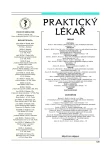-
Medical journals
- Career
Virus hepatitis B and C – basic information
Authors: P. Urbánek
Authors‘ workplace: IV. interní klinika 1. LF UK a VFN, Praha přednosta doc. MUDr. A. Žák, DrSc.
Published in: Prakt. Lék. 2005; 85(3): 138-144
Category: Various Specialization
Overview
Presented is a review of basic information on the causative agents, epidemiology, and therapy of viral hepatitis B and type C. Special attention is devoted to active and passive immunization, including post-exposure intervention.
The major route of transmission in virus hepatitis B is presently heterosexual intercourse. That is followed by intravenous drug abuse, homosexual activities and risky techniques of sexual intercourse. A significant route is also vertical transmission from mother to newborn. The virus of type B hepatitis belongs to the most complicated of DNA viruses, in the course of its replication cycle the original DNA being transcribed into RNA and then according to that template new viral DNA is formed. Very complicated is also the interaction between the virus and the immune system of the host organism. That interaction results in a varying clinical course on the one hand, and a number of so-called stages of infection on the other. In most cases those stages can be differentiated with the aid of serological diagnostic methods. However, for a correct interpretation of their results it is necessary to know the significance and function of each antigen and corresponding antibody. The significance of those proteins and the separate serological findings are explained in detail. Presently, specific antiviral therapy is indicated only in chronic infections with hepatitis B virus in the stage of active virus replication. There are two basic therapeutic options: interferon alpha and the virostatic lamivudin. In the case of infection with type B hepatitis virus there is available passive as well as active immunization, both being described in detail, including indications and vaccination procedures.
The virus of hepatitis C has been identified in 1989. The major route of transmission up to the year 1992 were products derived from blood; after 1992 when blood transfusion units began to use detection sets for demonstrating anti-HCV antibodies, the incidence of post-transfusion type C hepatitis fell almost to zero. Presently, the major route of transmission is intravenous drug abuse, however, no small share is played by health care. The basic serological marker of HCV infection are anti-HCV antibodies. Those antibodies are an indicator of contact with the virus, not necessarily meaning the subject has experienced an infection. Rather, the contrary is the case. In as hepatitis C virus infection passes into the chronic stage in up to 85% of cases, anti-HCV activity mostly signifies active infection with type C hepatitis virus. For the demonstration
of active infection there is necessary a positive demonstration of viral nucleic acid in the serum of the person investigated. The standard treatment of chronic infection with hepatitis C virus is a combination of pegylated interferon alpha and ribavirin, laeding to permanent elimination of the virus in 60% of cases. There is no available specific pre-exposure or post-exposure prophylaxis of hepatitis C virus infection. The only prevention of transmission of the disease is the avoiding of all risk factors of transmission, namely when affording health care.Key words:
hepatitis B virus – hepatitis C virus – lamivudin – interferon – pegylated interferon – vaccination.
Labels
General practitioner for children and adolescents General practitioner for adults
Article was published inGeneral Practitioner

2005 Issue 3-
All articles in this issue
- Post-traumatic strabism in adults (case report)
- Treatment of pain in the locomotor apparatus with the non-steroid anti-rheumatic of choice, nimesulid
- Rehabilitation and psychotherapy of patients suffering initial and chronic psychotic affections – Complex care at the day-patient community center “Fokus”
- Prescribing hypnotics in out-patient practice
- Informed selfcare
- Effect of eradicating H. pylori on the appearance of esophageal reflux disease: Randomized double blind study
- Virus hepatitis B and C – basic information
- Maintenance of the drain upon percutaneous transhepatic drainage of the biliary tract
- Oxygen in ophthalmology
- Replacement of the tricuspid valve and infective endocarditis
- General Practitioner
- Journal archive
- Current issue
- Online only
- About the journal
Most read in this issue- Maintenance of the drain upon percutaneous transhepatic drainage of the biliary tract
- Prescribing hypnotics in out-patient practice
- Effect of eradicating H. pylori on the appearance of esophageal reflux disease: Randomized double blind study
- Virus hepatitis B and C – basic information
Login#ADS_BOTTOM_SCRIPTS#Forgotten passwordEnter the email address that you registered with. We will send you instructions on how to set a new password.
- Career

